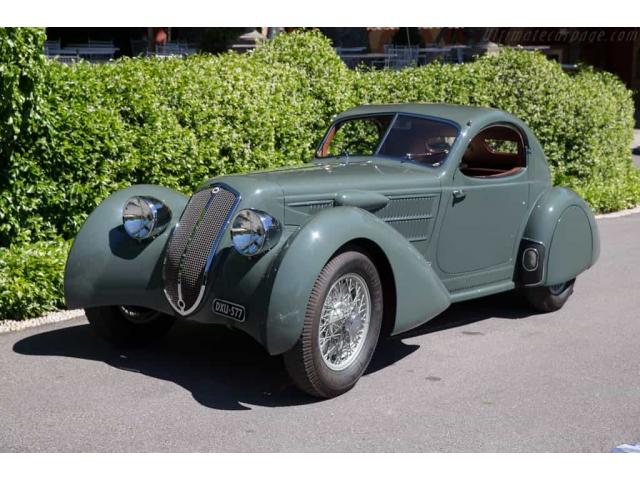1933 Lancia Astura Aerodinamico Castagna Coupé
- Brand: Lancia
1933 Lancia Astura Aerodinamico Castagna Coupé
In 1931, Lancia introduced two models two replace the revolutionary but ageing Lamba; the Artena and the Astura. Powered by a 2-litre V4, the Artena served as the company's new entry-level model, while the larger, sportier and more luxuriously appointed V8-engined Astura catered to more demanding customers.
Like the Lambda's V4, the Astura Tipo 85 V8 used an unusually narrow angle (19°) between the banks of cylinders. This typical Lancia feature provided the benefits of both a V and inline engine in that a short block could be used in combination with one integral cylinder head. Fitted vertically in the head the valves were actuated by a single overhead camshaft.
Cast in iron, the Tipo 85 V8 displaced just over 2.6 litre. Breathing through a single Zenith carburettor, mounted on top of the engine, Lancia's new eight cylinder engine produced 72 bhp at 4,000 rpm. The V8 was mated to a four-speed manual gearbox that drove the rear wheels.
Whereas the Lambda had pioneered monocoque construction, Lancia opted to use a more conventional steel ladder frame for the Astura, allowing for a much broader choice of (custom) coach-work. Suspension was independent at the front through Lancia's patented sliding pillars, while at the rear a traditional live rear axle was fitted.
Named after a monumental castle built on a small island near Nettuno on Italy's west coast, the Astura was launched late in 1931 during the Paris Auto Salon. Production commenced in earnest in 1932 when no fewer than 798 examples were built. Later that year a second series was introduced but this was virtually identical to the original model.
A more thorough revision came in the fall of 1933 when the 'third series' was announced. The most substantial change was the introduction of the Tipo 91 engine, which boasted an even narrower V-angle and a displacement increase to just under 3 litre. The third series Astura was available with a 3,332 mm and 3,100 mm wheelbase.
A final, and fourth evolution of the Astura was introduced late in 1937. The Tipo 91 engine was carried over but now fitted in a new platform chassis that was only available with a 3,475 mm wheelbase. Further changes included the addition of hydraulic brakes, an auto lube system for the chassis and an electric power top for the convertible model.
Despite the difficult economic times, the Astura sold well through the 1930s. The sophisticated machine proved to be a popular choice with Italy's many coach builders. In particular with Battista 'Pinin' Farina, who quickly emerged as one of the leading designers thanks to his creations for the Astura chassis. Castagna and Boneschi also produced spectacular coach work for the Astura.
Production of the Astura officially ceased in 1939 but several examples are known to have been built during the War; the Astura was also the car of choice for many prominent government officials. All series combined, an impressive 2,912 Asturas were produced.
During the mid-1930s, Castagna clothed four Astura chassis with this striking Aerodinamico Coupe body-style. The featured example is the only one of these four using a short wheelbase frame. The body fitted is believed to have actually been originally built for an Alfa Romeo 8C 2300 chassis in 1934. A year later, it was placed on this Astura frame. It was subsequently raced at the Pescara 24 Hours and shown at the Concorso d'Eleganza Coppo d'Oro Principessa di Piemonte. It has been suggested that both appearances were on behalf of the son of Benito Mussolini. Later in its life, it joined Peter Kaus' Rosso Bianco Collection. By that time, it had been re-painted red. During the mid-2000s, the entire collection was sold and this unique Astura joined a distinguished Dutch collection. For the new owner, it has been carefully restored with much time spent to find the correct shade of green that had been originally applied. The work was finally completed late in 2015, and in 2016, the car was awarded the Copa d'Oro at the Concorso d'Eleganza Villa d'Este.
Descriptions & pictures by ultimatecarpage & hiveminer & other
| Specification | |
| Production Start | 1933 |
| Country of origin | Italy |


































